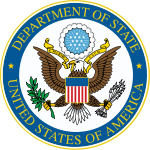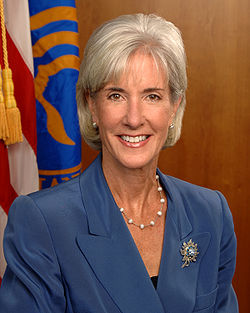United States Cabinet
| United States |
 This article is part of the series: |
|
|
Legislature
Presidency
Judiciary
Political parties
Federalism
|
|
Other countries · Atlas |
The United States Cabinet (usually referred to as the President's Cabinet or simplified as the Cabinet) is composed of the most senior appointed officers of the executive branch of the federal government of the United States. Its existence dates back to the first American President, George Washington, who appointed a Cabinet of four people (Secretary of State Thomas Jefferson; Secretary of the Treasury Alexander Hamilton; Secretary of War Henry Knox; and Attorney General Edmund Randolph) to advise and assist him in his duties. Cabinet officers are nominated by the President and then presented to the United States Senate for confirmation or rejection by a simple majority. If approved, they are sworn in and begin their duties. Aside from the Attorney General, and previously, the Postmaster General, they all receive the title Secretary. Members of the Cabinet serve at the pleasure of the President, which means the President may remove them at will.
Constitutional and legal basis
Confirmation requirement
Article Two, Section 2 of the U.S. Constitution says that the President
| “ | shall nominate, and by and with the Advice and Consent of the Senate, shall appoint Ambassadors, other public Ministers and Consuls, Judges of the supreme Court, and all other Officers of the United States, whose Appointments are not herein otherwise provided for, and which shall be established by Law: but the Congress may by Law vest the Appointment of such inferior Officers, as they think proper, in the President alone, in the Courts of Law, or in the Heads of Departments. | ” |
Other Constitutional references to the Cabinet
Article Two of the Federal Constitution provides that the President can require "the Opinion, in writing, of the principal Officer in each of the executive Departments, upon any Subject relating to the Duties of their respective Offices."[1] The Constitution did not then establish the names (or list or limit the number) of Cabinet departments. These details were left to Congress and the President to determine.
Later, upon the ratification of the 25th Amendment to the Constitution, a provision was created allowing the Vice-President and "a majority of the principal officers" of the executive branch departments to transmit a notice (to the Speaker of the House and the U.S. Senate's President pro tempore) that the President is unfit for office. If the President contests this finding, then the U.S. Congress is directed to settle the matter.
U.S. Cabinet nominees are chosen from a very large pool of potential candidates. One of the few qualification restrictions is set out in the Ineligibility Clause of Article One of the Federal Constitution: "no person holding any office under the United States, shall be a member of either house during his continuance in office." Accordingly, a sitting member of the U.S. Congress must resign from his/her seat in Congress to accept a Cabinet appointment. This clause also bars any member of Congress from holding an executive office that was created by law during his/her current term in Congress.
This constitutional separation between the Executive Branch and the Legislative Branche is the very opposite of the British, Canadian, or Australian parliamentary cabinet systems, where the members of the Cabinet are required by long-standing precedents to be sitting members of the legislature.
The Cabinet in federal law
There is no explicit definition of the term "Cabinet" in either the United States Code or the Code of Federal Regulations. However, there are occasional references to "cabinet-level officers" or "secretaries", which when viewed in their context do refer to the heads of the "executive departments" as listed in 5 U.S.C. § 101.
Under 5 U.S.C. § 3110 Federal officials are prohibited from appointing family members to certain governmental posts, including seats in the Cabinet. Passed in 1967, the law was a response to John F. Kennedy's appointment of his brother Robert F. Kennedy to the office of the Federal Attorney General.
Salary
Cabinet officials receive an amount of pay determined by Title 5 of the United States Code. According to 5 U.S.C. § 5312, Cabinet level positions qualify for Level I pay, which amounts to $199,700. Some cabinet-level officials, including the Vice-President of the United States and the White House Chief of Staff, have their salaries determined differently.
Precedence and succession

Order of precedence
During a meeting of the President's Cabinet, members are seated according to the order of precedence, with higher ranking officers sitting closer to the center of the table. Hence, the President and Vice President sit directly across from each other at the middle of the oval shaped table. Then, the Secretaries of State and Defense are seated directly to the right and left, respectively, of the President and the Secretary of Treasury and the Attorney General sit to right and left, respectively, of the Vice President. This alternation according to rank continues, with Cabinet-rank members (those not heading executive departments, the Vice President excluded) sitting at the very ends, farthest away from the President and Vice President.
Line of succession
The Cabinet is also important in the presidential line of succession, which determines an order in which Cabinet officers succeed to the office of the president following the death or resignation of the president. At the top of the order of succession are the Vice President, Speaker of the House and President pro tempore of the Senate, and Secretary of State. Because of this, it is common practice not to have the entire Cabinet in one location, even for ceremonial occasions like the State of the Union Address, where at least one Cabinet member does not attend. This person is the designated survivor, and he or she is held at a secure, undisclosed location, ready to take over if the President, Vice President, Speaker of the House, President pro tempore of the Senate, Secretary of State and the rest of the Cabinet are killed.
Cabinet and Cabinet-level officials

The men and women listed below were nominated by President Barack Obama to form his initial Cabinet and were confirmed by the United States Senate on the date noted. An elected Vice President does not require Senate confirmation, nor do White House staff positions like chief of staff or press secretary.
Secretary Gates was previously confirmed by the Senate (as President Bush's Secretary of Defense) and therefore did not need to be re-confirmed.
Cabinet
| Department | Office | Incumbent | Image | in Office since |
|---|---|---|---|---|
 Department of State |
Secretary of State | Hillary Rodham Clinton |  |
January 21, 2009 |
 Department of the Treasury |
Secretary of the Treasury | Timothy Geithner |  |
January 26, 2009 |
 Department of Defense |
Secretary of Defense | Robert Gates |  |
December 18, 2006 |
 Department of Justice |
Attorney General | Eric Holder |  |
February 2, 2009 |
 Department of the Interior |
Secretary of the Interior | Ken Salazar |  |
January 21, 2009 |
 Department of Agriculture |
Secretary of Agriculture | Tom Vilsack |  |
January 21, 2009 |
 Department of Commerce |
Secretary of Commerce | Gary Locke |  |
March 24, 2009 |
 Department of Labor |
Secretary of Labor | Hilda Solis |  |
February 24, 2009 |
 Department of Health and Human Services |
Secretary of Health and Human Services | Kathleen Sebelius |  |
April 28, 2009 |
 Department of Housing and Urban Development |
Secretary of Housing and Urban Development | Shaun Donovan |  |
January 26, 2009 |
 Department of Transportation |
Secretary of Transportation | Ray LaHood |  |
January 22, 2009 |
 Department of Energy |
Secretary of Energy | Steven Chu |  |
January 21, 2009 |
 Department of Education |
Secretary of Education | Arne Duncan |  |
January 21, 2009 |
 Department of Veterans Affairs |
Secretary of Veterans Affairs | Eric Shinseki |  |
January 21, 2009 |
 Department of Homeland Security |
Secretary of Homeland Security | Janet Napolitano |  |
January 21, 2009 |
Cabinet-level officers
| Department | Office | Incumbent | Image | in Office since |
|---|---|---|---|---|
 Office of the Vice President |
Vice President | Joseph Biden |  |
January 20, 2009 |
 Executive Office of the President |
White House Chief of Staff | Rahm Emanuel |  |
January 20, 2009 |
 Office of Management and Budget |
Acting Director of the Office of Management and Budget | Jeffrey Zients |  |
July 30, 2010 |
 Office of the U.S. Trade Representative |
Trade Representative | Ron Kirk |  |
March 18, 2009 |
 Environmental Protection Agency |
Administrator of the Environmental Protection Agency | Lisa P. Jackson |  |
January 22, 2009 |
 United States Mission to the United Nations |
Ambassador to the United Nations | Susan Rice |  |
January 22, 2009 |
 Council of Economic Advisers |
Chairman of the Council of Economic Advisers | Christina Romer |  |
January 28, 2009 |
Former Cabinet departments
- Department of War (1789–1947): subsumed into new Department of Defense.
- Department of the Navy (1798–1947): subsumed into new Department of Defense.
- Post Office Department (1829–1971), headed by the Postmaster General: reorganized as the United States Postal Service, an independent executive agency.
Renamed Cabinet offices
- Secretary of Foreign Affairs: created in July 1789 and renamed Secretary of State in September 1789.[2]
- Secretary of Commerce and Labor: created in 1903 and renamed Secretary of Commerce in 1913 when its labor functions were transferred to the new Secretary of Labor.
- Secretary of Health, Education, and Welfare: created in 1953 and renamed Secretary of Health and Human Services in 1979 when its education functions were transferred to the new Secretary of Education.
Executive officials no longer of Cabinet rank
- Director of the Federal Security Agency (1939–1952): Abolished, most duties transferred to the Department of Health, Education, and Welfare
- Director of the Federal Emergency Management Agency (1996–2001): created as an independent agency in 1979, raised to Cabinet rank in 1996,[3] lost Cabinet rank in 2001.[4]
- Director of Central Intelligence (1995–2001)[5][6][7]
- Director of the Office of National Drug Control Policy (1993–2009)[8][9]
- Administrator of the Small Business Administration (1994–2001)[10]
Proposed Cabinet departments
- U.S. Department of Commerce and Industry (proposed by business interests in the 1880s)
- U.S. Department of Agriculture and Labor (proposed by members of U.S. Congress)
- U.S. Department of Peace (proposed by Congressman Dennis Kucinich, Senator Matthew Neely, and other members of the U.S. Congress)[11]
- U.S. Department of Public Welfare (proposed by President Warren Harding)
- U.S. Department of Natural Resources (proposed by former President Herbert Hoover, the Eisenhower administration, President Richard Nixon and the GOP national platform in 1976)
- U.S. Department of Social Welfare (proposed by President Franklin Roosevelt)
- U.S. Department of Public Works (proposed by President Franklin Roosevelt)
- U.S. Department of Conservation (proposed by Interior Secretary Harold L. Ickes)
- U.S. Department of Urban Affairs (proposed by President John F. Kennedy)
- U.S. Department of Business and Labor (proposed by President Lyndon Johnson)
- U.S. Department of Community Development (proposed by President Richard Nixon; to be chiefly concerned with infrastructure)
- U.S. Department of Human Resources (proposed by President Richard Nixon; essentially a revised Department of Health, Education, and Welfare)
- U.S. Department of Economic Development (proposed by President Richard Nixon; essentially a consolidation of the Departments of Commerce and Labor)
- U.S. Department of Environmental Protection (proposed by Senator Arlen Specter)
- U.S. Department of International Trade (proposed by the Heritage Foundation)
- U.S. Department of Global Development (proposed by the Center for Global Development and others)
- U.S. Department of Culture (proposed by Quincy Jones)[12]
Lists of Cabinets
See also
- Black Cabinet
- List of first African Americans to hold U.S. Cabinet Secretaryships
- List of first women to hold U.S. Cabinet Secretaryships
- List of United States political appointments that crossed party lines
- List of US Cabinet Secretaries who have held multiple cabinet-level positions
- Living former cabinet members
References
- ↑ Constitution of the United States, gpoaccess.gov
- ↑ The office of Secretary of Foreign Affairs existed under the Articles of Confederation from October 20, 1781 to March 3, 1789, the day before the Constitution came into force.
- ↑ Feberal Emergency Management Agency (1996-02-26). "President Clinton Raises FEMA Director to Cabinet Status". Press release. http://web.archive.org/web/19970116185236/www.fema.gov/home/NWZ96/cabinet.htm. Retrieved 2009-05-22.
- ↑ Fowler, Daniel (2008-11-19). "Emergency Managers Make It Official: They Want FEMA Out of DHS". CQ Politics. http://www.cqpolitics.com/wmspage.cfm?docID=hsnews-000002988269&cpage=1. Retrieved 2010-03-03. "During the Clinton administration, FEMA Administrator James Lee Witt met with the cabinet. His successor in the Bush administration, Joe M. Allbaugh, did not." (Archived by WebCite at http://www.webcitation.org/5ny13zsIv)
- ↑ Tenet, George (2007). At the Center of the Storm. London: HarperCollins. p. 136. ISBN 0061147788. "Under President Clinton, I was a cabinet member - a legacy of John Deutch's requirement when he took the job as DCI - but my contacts with the president, while always interesting, were sporadic. I could see him as often as I wanted but was not on a regular schedule. Under President Bush, the DCI lost its Cabinet-level status."
- ↑ Schoenfeld, Gabriel (July/August 2007). "The CIA Follies (Cont'd.)". Commentary. https://www.commentarymagazine.com/viewarticle.cfm/the-cia-follies--cont-d--10897?page=all. Retrieved 2009-05-22. "Though he was to lose the cabinet rank he had enjoyed under Clinton, he came to enjoy “extraordinary access” to the new President, who made it plain that he wanted to be briefed every day."
- ↑ Sciolino, Elaine (1996-09-29). "C.I.A. Chief Charts His Own Course". New York Times. http://www.nytimes.com/1996/09/29/us/cia-chief-charts-his-own-course.html?scp=5&sq=John%20M.%20Deutch%20cabinet%20rank&st=nyt&pagewanted=all. Retrieved 2009-05-22. "It is no secret that Mr. Deutch initially turned down the intelligence position, and was rewarded for taking it by getting cabinet rank."
- ↑ Clinton, Bill (1993-07-01). "Remarks by the President and Lee Brown, Director of Office of National Drug Control Policy". White House. http://clinton6.nara.gov/1993/07/1993-07-01-presidents-remarks-at-swearing-in-of-lee-brown.html. Retrieved 2009-05-22. "We are here today to install a uniquely qualified person to lead our nation's effort in the fight against illegal drugs and what they do to our children, to our streets, and to our communities. And to do it for the first time from a position sitting in the President's Cabinet."
- ↑ Cook, Dave (2009-03-11). "New drug czar gets lower rank, promise of higher visibility". Christan Science Monitor. http://features.csmonitor.com/politics/2009/03/11/new-drug-czar-gets-lower-rank-promise-of-higher-visibility/. Retrieved 2009-03-16. "For one thing, in the Obama administration the Drug Czar will not have Cabinet status, as the job did during George W. Bush’s administration."
- ↑ Staff reporter (2009-02-09). "Bipartisan leaders of the Senate Small Business Committee renewed their call for President Obama to elevate the SBA administrator to cabinet-level status". Business Research Services, Inc.. http://features.csmonitor.com/politics/2009/03/11/new-drug-czar-gets-lower-rank-promise-of-higher-visibility/. Retrieved 2009-05-22. "The SBA administrator held cabinet rank in the Clinton administration, but not under President Bush."
- ↑ "History of Legislation to Create a Dept. of Peace". http://www.thepeacealliance.org/content/view/54/130/.
- ↑ Clarke, Jr., John (2009-01-16). "Quincy Jones Lobbies Obama for Secretary of Culture Post". Rolling Stone. http://www.rollingstone.com/music/news/15765/90864. Retrieved 2010-08-19.
Further reading
- Bennett, Anthony. The American President's Cabinet. Houndmills, Basingstoke, Hampshire: Macmillan, 1996. ISBN 0-333-60691-4. A study of the U.S. Cabinet from Kennedy to Clinton.
- Grossman, Mark. Encyclopedia of the United States Cabinet (three volumes). Santa Barbara, California: ABC-CLIO, 2000. ISBN 0-87436-977-0. A history of the United States and Confederate States cabinets, their secretaries, and their departments.
- Rudalevige, Andrew. "The President and the Cabinet", in Michael Nelson, ed., The Presidency and the Political System, 8th ed. (Washington, D.C.: CQ Press, 2006).
External links
- Official site of the President's Cabinet
- U.S. Senate's list of cabinet members who did not attend the State of the Union Address (since 1984)
|
|||||||||||||||||||||||||||||||||||||||||||||||||||||||||||||||||||||||||||||||||||||
|
|||||||||||||
|
|||||||||||
|
||||||||||||||||||||||||||||||||||||||||||||||
